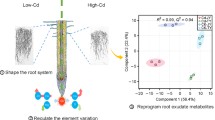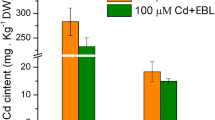Abstract
Exogenous regulation of plant physiology is a kind of effective approach to help plant grow under Cd (cadmium)-contaminated environment. CA (cinnamaldehyde) is an environmental friendly natural compound with medicinal properties and antimicrobial activities. In this work, we found that CA was able to confer plant Cd tolerance by priming defense in the root of B. rapa. Pretreatment with CA attenuated the phytotoxicity induced by subsequent Cd stress, such as root growth inhibition, ROS accumulation, oxidative injury, and cell death in root tip. Cd stress decreased the intracellular Ca2+ level in roots, which could be enhanced by pretreatment with CA. Pretreatment with a Ca2+ chelator or a Ca2+ channel blocker blocked all the beneficial effects of CA on the increase in the intracellular Ca2+ level and the amelioration of physiological injury in roots under Cd stress. Correlation analysis combined with cluster analysis suggested that CA was able to prime plant defense by regulating endogenous Ca2+ in order to facilitate Cd tolerance. These results shed a new light on the novel role of CA in modulating plant resistant physiology against metal stress, which may extend our knowledge on both CA and plant Cd tolerance.







Similar content being viewed by others
References
Ahmad, P., Sarwat, M., Bhat, N. A., Wani, M. R., Kazi, A. G., & Tran, L.-S. P. (2015). Alleviation of cadmium toxicity in Brassica juncea L. (Czern. & Coss.) by calcium application involves various physiological and biochemical strategies. PLoS One, 10(1), e0114571.
Ali, S. M., Khan, A. A., Ahmed, I., Musaddiq, M., Ahmed, K. S., Polasa, H., et al. (2005). Antimicrobial activities of Eugenol and Cinnamaldehyde against the human gastric pathogen Helicobacter pylori. Annals of Clinical Microbiology and Antimicrobials, 4(1), 1–7.
Aranega-Bou, P., de la O Leyva, M., Finiti, I., García-Agustín, P., & González-Bosch, C. (2014). Priming of plant resistance by natural compounds. Hexanoic acid as a model. Frontiers in Plant Science, 5, 488.
Chmielowska-Bąk, J., Gzyl, J., Rucińska-Sobkowiak, R., Arasimowicz-Jelonek, M., & Deckert, J. (2014). The new insights into cadmium sensing. Frontiers in Plant Science, 5, 245.
DalCorso, G., Farinati, S., & Furini, A. (2010). Regulatory networks of cadmium stress in plants. Plant Signaling & Behavior, 5(6), 663–667.
de Hoon, M. J. L., Imoto, S., Nolan, J., & Miyano, S. (2004). Open source clustering software. Bioinformatics, 20(9), 1453–1454.
Demidchik, V., Shabala, S., Isayenkov, S., Cuin, T. A., & Pottosin, I. (2018). Calcium transport across plant membranes: Mechanisms and functions. The New Phytologist, 220(1), 49–69.
Dunand, C., Crèvecoeur, M., & Penel, C. (2007). Distribution of superoxide and hydrogen peroxide in Arabidopsis root and their influence on root development: Possible interaction with peroxidases. The New Phytologist, 174(2), 332–341.
Fasani, E., DalCorso, G., Costa, A., Zenoni, S., & Furini, A. (2019). The Arabidopsis thaliana transcription factor MYB59 regulates calcium signalling during plant growth and stress response. Plant Molecular Biology, 99(6), 517–534.
Foreman, J., Demidchik, V., Bothwell, J. H., Mylona, P., Miedema, H., Torres, M. A., et al. (2003). Reactive oxygen species produced by NADPH oxidase regulate plant cell growth. Nature, 422(6930), 442–446.
Fu, S., Li, L., Kang, H., Yang, X., Men, S., & Shen, Y. (2017). Chronic mitochondrial calcium elevation suppresses leaf senescence. Biochemical and Biophysical Research Communications, 487(3), 672–677.
Han, Y., Zhang, J., Chen, X., Gao, Z., Xuan, W., Xu, S., et al. (2008). Carbon monoxide alleviates cadmium-induced oxidative damage by modulating glutathione metabolism in the roots of Medicago sativa. The New Phytologist, 177(1), 155–166.
Hu, L., Li, H., Huang, S., Wang, C., Sun, W. J., Mo, H. Z., et al. (2018). Eugenol confers cadmium tolerance via intensifying endogenous hydrogen sulfide signaling in Brassica rapa. Journal of Agricultural and Food Chemistry, 66(38), 9914–9922.
Hu, L., Wang, D., Liu, L., Chen, J., Xue, Y., & Shi, Z. (2013). Ca2+ efflux is involved in cinnamaldehyde-induced growth inhibition of Phytophthora capsici. PLoS One, 8(10), e76264.
Huang, D., Gong, X., Liu, Y., Zeng, G., Lai, C., Bashir, H., et al. (2017). Effects of calcium at toxic concentrations of cadmium in plants. Planta, 245(5), 863–873.
Ismael, M. A., Elyamine, A. M., Moussa, M. G., Cai, M., Zhao, X., & Hu, C. (2019). Cadmium in plants: Uptake, toxicity, and its interactions with selenium fertilizers. Metallomics, 11(2), 255–277.
Kang, L.-L., Zhang, D.-M., Ma, C.-H., Zhang, J.-H., Jia, K.-K., Liu, J.-H., et al. (2016). Cinnamaldehyde and allopurinol reduce fructose-induced cardiac inflammation and fibrosis by attenuating CD36-mediated TLR4/6-IRAK4/1 signaling to suppress NLRP3 inflammasome activation. Scientific Reports, 6, 27460. https://doi.org/10.21038/srep27460.
Leitão, N., Dangeville, P., Carter, R., & Charpentier, M. (2019). Nuclear calcium signatures are associated with root development. Nature Communications, 10(1), 4865.
Li, P., Zhao, C., Zhang, Y., Wang, X., Wang, J., Wang, F., et al. (2016). Calcium alleviates cadmium-induced inhibition on root growth by maintaining auxin homeostasis in Arabidopsis seedlings. Protoplasma, 253(1), 185–200.
Li, Y. J., Chen, J., Xian, M., Zhou, L. G., Han, F. X., Gan, L. J., et al. (2014). In site bioimaging of hydrogen sulfide uncovers its pivotal role in regulating nitric oxide-induced lateral root formation. PLoS One, 9(2), e90340.
Liu, Y. Y., Wang, R. L., Zhang, P., Sun, L. L., & Xu, J. (2016). Involvement of reactive oxygen species in lanthanum-induced inhibition of primary root growth. Journal of Experimental Botany, 67(21), 6149–6159.
Lv, C., Yuan, X., Zeng, H. W., Liu, R. H., & Zhang, W. D. (2017). Protective effect of cinnamaldehyde against glutamate-induced oxidative stress and apoptosis in PC12 cells. European Journal of Pharmacology, 815, 487–494.
Mathavarajah, S., Salsman, J., & Dellaire, G. (2019). An emerging role for calcium signalling in innate and autoimmunity via the cGAS-STING axis. Cytokine & Growth Factor Reviews, 50, 43–51.
Meena, V., Sree, S. N., Surya, P. D. V., & Sumanjali, A. (2012). A review on pharmacological activities and clinical effects of Cinnamon species. Research Journal of Pharmaceutical, Biological and Chemical Sciences, 3, 653–663.
Mostofa, M. G., Rahman, A., Ansary, M. M. U., Watanabe, A., Fujita, M., & Tran, L.-S. P. (2015). Hydrogen sulfide modulates cadmium-induced physiological and biochemical responses to alleviate cadmium toxicity in rice. Scientific Reports, 5, 14078.
Pérez-Chaca, M. V., RodrÍGuez-Serrano, M., Molina, A. S., Pedranzani, H. E., Zirulnik, F., Sandalio, L. M., et al. (2014). Cadmium induces two waves of reactive oxygen species in Glycine max (L.) roots. Plant, Cell & Environment, 37(7), 1672–1687.
Perilli, S., Di Mambro, R., & Sabatini, S. (2012). Growth and development of the root apical meristem. Current Opinion in Plant Biology, 15(1), 17–23.
Pires, P. W., & Earley, S. (2018). Neuroprotective effects of TRPA1 channels in the cerebral endothelium following ischemic stroke. eLife, 7, e35316.
Qadir, S., Jamshieed, S., Rasool, S., Ashraf, M., Akram, N. A., & Ahmad, P. (2014). Modulation of plant growth and metabolism in cadmium-enriched environments. Reviews of Environmental Contamination and Toxicology, 229, 51–88.
Raffai, G., Kim, B., Park, S., Khang, G., Lee, D., & Vanhoutte, P. M. (2014). Cinnamaldehyde and cinnamaldehyde-containing micelles induce relaxation of isolated porcine coronary arteries: Role of nitric oxide and calcium. International Journal of Nanomedicine, 9, 2557–2566.
Ranasinghe, P., Pigera, S., Premakumara, G. S., Galappaththy, P., Constantine, G. R., & Katulanda, P. (2013). Medicinal properties of ‘true’ cinnamon (Cinnamomum zeylanicum): A systematic review. BMC Complementary and Alternative Medicine, 13, 275. https://doi.org/10.1186/1472-6882-1113-1275.
Rodríguez-Serrano, M., Romero-Puertas, M. C., Pazmiño, D. M., Testillano, P. S., Risueño, M. C., Del Río, L. A., et al. (2009). Cellular response of pea plants to cadmium toxicity: Cross talk between reactive oxygen species, nitric oxide, and calcium. Plant Physiology, 150, 229–243.
Saijo, Y., & Loo, E. P. (2020). Plant immunity in signal integration between biotic and abiotic stress responses. The New Phytologist, 225(1), 87–104.
Shi, H., Ye, T., & Chan, Z. (2014). Nitric oxide-activated hydrogen sulfide is essential for cadmium stress response in bermudagrass (Cynodon dactylon (L). Pers.). Plant Physiology and Biochemistry, 74, 99–107.
Siddiqui, M. H., Al-Whaibi, M. H., Sakran, A. M., Basalah, M. O., & Ali, H. M. (2012). Effect of calcium and potassium on antioxidant system of Vicia faba L. under cadmium stress. International Journal of Molecular Sciences, 13(6), 6604–6619.
Subash-Babu, P., Alshatwi, A. A., & Ignacimuthu, S. (2014). Beneficial antioxidative and antiperoxidative effect of cinnamaldehyde protect streptozotocin-induced pancreatic β-cells damage in wistar rats. Biomolecules & Therapeutics, 22(1), 47–54.
Thor, K. (2019). Calcium-nutrient and messenger. Frontiers in Plant Science, 10, 440.
Wang, D., Hou, J., Yang, Y., Zhou, P., Liu, S., Wan, J., et al. (2019). Cinnamaldehyde ameliorates high-glucose-induced oxidative stress and cardiomyocyte injury through transient receptor potential ankyrin 1. Journal of Cardiovascular Pharmacology, 74(1), 30–37.
Wang, Y. S., & Yang, Z. M. (2005). Nitric oxide reduces aluminum toxicity by preventing oxidative stress in the roots of Cassia tora L. Plant & Cell Physiology, 46(12), 1915–1923.
Wen, J., Deng, M., & Gong, M. (2012). Cd2+ stress induces two waves of H2O2 accumulation associated with ROS-generating system and ROS-scavenging system in cultured tobacco cells. Australian Journal of Crop Science, 6, 846–853.
Wu, Z., Weng, S., Yan, D., Xie, Z., Zhou, Q., Li, H., et al. (2018). Administration of cinnamaldehyde promotes osteogenesis in ovariectomized rats and differentiation of osteoblast in vitro. Journal of Pharmacological Sciences, 138(1), 63–70.
Xu, J., Zhu, Y., Ge, Q., Li, Y., Sun, J., Zhang, Y., et al. (2012). Comparative physiological responses of Solanum nigrum and Solanum torvum to cadmium stress. The New Phytologist, 196(1), 125–138.
Xue, Y. F., Zhang, M., Qi, Z. Q., Li, Y. Q., Shi, Z., & Chen, J. (2015). Cinnamaldehyde promotes root branching by regulating endogenous hydrogen sulfide. Journal of the Science of Food and Agriculture, 96(3), 909–914.
Yamamoto, Y., Kobayashi, Y., Devi, S. R., Rikiishi, S., & Matsumoto, H. (2002). Aluminum toxicity is associated with mitochondrial dysfunction and the production of reactive oxygen species in plant cells. Plant Physiology, 128(1), 63–72.
Yamamoto, Y., Kobayashi, Y., & Matsumoto, H. (2001). Lipid peroxidation is an early symptom triggered by aluminum, but not the primary cause of elongation inhibition in pea roots. Plant Physiology, 125(1), 199–208.
Yang, C.-M., & Juang, K.-W. (2015). Alleviation effects of calcium and potassium on cadmium rhizotoxicity and absorption by soybean and wheat roots. Journal of Plant Nutrition and Soil Science, 178(5), 748–754.
Ye, X., Ling, T., Xue, Y., Xu, C., Zhou, W., Hu, L., et al. (2016). Thymol mitigates cadmium stress by regulating glutathione levels and reactive oxygen species homeostasis in tobacco seedlings. Molecules, 21(10), 1339.
Youn, H. S., Lee, J. K., Choi, Y. J., Saitoh, S. I., Miyake, K., Hwang, D. H., et al. (2008). Cinnamaldehyde suppresses toll-like receptor 4 activation mediated through the inhibition of receptor oligomerization. Biochemical Pharmacology, 75(2), 494–502.
Acknowledgments
We thank Mr. Cunfa Xu from Central Laboratory, Jiangsu Academy of Agricultural Sciences, for his technical support during stereoscopic microscope study.
Funding
This study was supported by the National Natural Science Foundation of China (31771705), Jiangsu Agricultural Science and Technology Innovation Fund (CX(20)1011), and Program for Tackling Key Problems in Science and Technology of Henan Province (202102110046).
Author information
Authors and Affiliations
Corresponding authors
Ethics declarations
Conflict of Interest
The authors declare that they have no conflict of interest.
Additional information
Publisher’s Note
Springer Nature remains neutral with regard to jurisdictional claims in published maps and institutional affiliations.
Rights and permissions
About this article
Cite this article
Cheng, Y., Wang, N., Liu, R. et al. Cinnamaldehyde Facilitates Cadmium Tolerance by Modulating Ca2+ in Brassica rapa. Water Air Soil Pollut 232, 19 (2021). https://doi.org/10.1007/s11270-020-04952-w
Received:
Accepted:
Published:
DOI: https://doi.org/10.1007/s11270-020-04952-w




